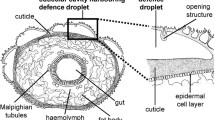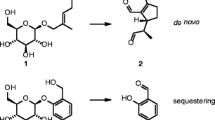Abstract
Bombardier beetles are well-known for their remarkable defensive mechanism. Their defensive apparatus consists of two compartments known as the reservoir and the reaction chamber. When challenged, muscles surrounding the reservoir contract sending chemical precursors into the reaction chamber where they mix with enzymes resulting in an explosive discharge of a hot noxious chemical spray containing two major quinones: 1,4-benzoquinone and 2-methyl-1,4-benzoquinone (toluquinone). Previously, it has been speculated that the biosynthesis of all benzoquinones originates from one core precursor, 1,4-hydroquinone. Careful ligation of the base of the reservoir chamber enabled us to prevent the explosive reaction and sample untransformed reservoir fluid, which showed that it accumulates significant quantities of 1,4-hydroquinone and 2-methyl-1,4-hydroquinone. We investigated the biosynthetic mechanisms leading to quinone formation by injecting or feeding Brachinus elongatulus beetles with stable-isotope-labeled precursors. Chemical analysis of defensive secretion samples obtained from 1,4-hydroquinone-d6-administered beetles demonstrated that it underwent conversion specifically to 1,4-benzoquinone. Analogously, results from m-cresol-d8 injected or fed beetles confirmed that m-cresol is metabolized to 2-methyl-1,4-hydroquinone, which is then oxidized to 2-methyl-1,4-benzoquinone in the hot spray. Our results refute the previous claim that 1,4-hydroquinone is the precursor of all substituted benzoquinones in bombardier beetles and reveal that they are biosynthetic products of two independent pathways. Most likely, the aforementioned biosynthetic channel of hydroxylation of appropriate phenolic precursors and subsequent oxidation is not restricted to bombardier beetles; it could well be a general pathway that leads to the formation of all congeners of benzoquinones, one of the most widely distributed groups of defensive compounds in arthropods.

Graphical abstract










Similar content being viewed by others

References
Abraham I, Joshi R, Pardasani P, Pardasani RT (2011) Recent advances in 1,4-benzoquinone chemistry. J Braz Chem Soc 22:385–421
Aneshansley DJ, Eisner T, Widom JM, Widom B (1969) Biochemistry at 100°C: explosive secretory discharge of bombardier beetles (Brachinus). Science 165:61–63
Arndt EM, Moore W, Lee W-K, Ortiz C (2015) Mechanistic origins of bombardier beetle (Brachinini) explosion-induced defensive spray pulsation. Science 348:563–567
Arndt E, Beutel RG, Will KW (2017) Carabidae Latreille, 1802. In R. G. Beutel & R. A. B. Leschen (Eds.), Handbook of zoology, Vol. IV: Arthropoda: Insecta (series ed. by N.P. Kristensen and R.G. Beutel). Part 38. Coleoptera, Vol. 1: Morphology and systematics (Archostemata, Adephaga, Myxophaga, Polyphaga (partim). 2nd ed. New York: Walter De Gruyter, Berlin. pp 119-146
Artigot MP, Loiseau N, Laffitte J, Mas-Reguieg L, Tadrist S, Oswal IP, Puel O (2009) Molecular cloning and functional characterization of two CYP619 cytochrome P450s involved in biosynthesis of patulin in Aspergillus clavatus. Microbiology 155:1738–1747
Balestrazzi E, Dazzini-Valcurone ML, Bernardi MD, Vidari G, Vita-Finzi P, Mellerio G (1985) Morphological and chemical studies on the pygidial defence glands of some Carabidae (Coleoptera). Naturwissenschaften 72:482–484
Beynon JH, Williams AE (1960) Mass spectra of various quinones and polycyclic ketones. Appl Spectrosc 14:156–160
Blum M (1981) Chemical defenses of arthropods. Academic Press, Waltham
Blum MS (1987) Biosynthesis of arthropod exocrine compounds. Annu Rev Entomol 32:381–413
Bodner M, Vagalinski B, Makarov SE, Antić DŽ, Vujisić LV, Leis HJ, Raspotnig G (2016) “Quinone millipedes” reconsidered: evidence for a mosaic-like taxonomic distribution of phenol-based secretions across the Julidae. J Chem Ecol 42:249–258
Bradshaw JWS (1985) Insect natural products — compounds derived from acetate, Shikimate and amino acids. In: Kerkut GA, Gilbert LI (eds) Comprehensive insect physiology biochemistry and pharmacology, Pharmacology, vol 11. Elsevier, Amsterdam, pp 655–703
Buser H-R, Arn GP, Rauscher S (1983) Determination of double bond position in mono-unsaturated acetates by mass spectrometry of dimethyl disulfide adduct. Anal Chem 55:818–822
Chadha MS, Eisner T, Meinwald J (1961) Defence mechanisms of arthropods—IV: para-benzoquinones in the secretion of Eleodes longicollis Lec. (Coleoptera: Tenebrionidae). J Insect Physiol 7:46–48
Dazzini-Valcurone M, Pavan M (1980) Glandole pigidiali e secrezioni difensive dei Carabidae (Insecta Coleoptera). Publicazioni dell’Ist Entomol Univ di Pavia 12:36
Dean J, Aneshansley DJ, Edgerton HE, Eisner T (1990) Defensive spray of the bombardier beetle: a biological pulse jet. Science 248:1219–1221
Deml R, Huth A (2000) Benzoquinones and hydroquinones in defensive secretions of tropical millipedes. Naturwissenschaften 87:80–82
Dettner K (1985) Ecological and phylogenetic significance of defensive compounds from pygidial glands of Hydradephaga Coleoptera. Proceedings of the Academy of Natural Sciences. 1st International Conference on Classification, Phylogeny, and Natural History of Hydradephaga, Held at the 1982 Joint Meeting of the Entomological Societies of America, Canada, and Ontario 137:156–171
Dettner K (1991) Solvent-dependent variability of effectiveness of quinone-defensive systems of Oxytelinae beetles (Coleoptera: Staphylinidae). Entomologia Generalis 15:275–292
Dettner K (2010) Chemical defense and toxins of lower terrestrial and freshwater animals. In: Mori K (ed) Comprehensive natural products II: chemistry and biology, chemical ecology, vol 4. Elsevier, Amsterdam, pp 387–410
Di Giulio A, Muzzi M, Romani R (2015) Functional anatomy of the explosive defensive system of bombardier beetles (Coleoptera, Carabidae, Brachininae). Arthropod Struct Dev 44:468–490
Dufey SS (1974) The biosynthesis of defensive chemicals by millipedes: parallelism with plant biosynthetic pathways. Ph.D. thesis, The University of British Columbia
Eisner T (1958) The protective role of the spray mechanism of the bombardier beetle, Brachynus ballistarius Lec. J Insect Physiol 2:215–220
Eisner T, Aneshansley DJ (1982) Spray aiming in bombardier beetles: jet deflection by Coanda effect. Science 215:83–85
Eisner T, Jones TH, Aneshansley DJ, Tschinkel WR, Silberglied RE, Meinwald J (1977) Chemistry of defensive secretions of bombardier beetles (Brachinini, Metriini, Ozaenini, Paussini). J Insect Physiol 23:1383–1386
Eisner T, Rossini C, Eisner M (2000) Chemical defense of an earwig (Doru taeniatum). Chemoecology 10:81–87
Eisner T, Rossini C, González A, Eisner M (2004) Chemical defense of an opilionid (Acanthopachylus aculeatus). J Exp Biol 207:1313–1321
Fieser LF, Ardao MI (1955) Investigation of the chemical nature of gonyleptidine. J Amer Chem Soc 78:774–781
Francis GW, Veland K (1987) Alkylthiolation for the determination of double-bond positions in linear alkenes. J Chromatogr A 219:379–384
Gasch T, Schott M, Wehrenfennig C, Düring R-A, Vilcinskas A (2013) Multifunctional weaponry: the chemical defenses of earwigs. J Insect Physiol 59:1186–1193
Gnaspini P, Cavalheiro AJ (1998) Chemical and behavioral defenses of a neotropical cavernicolous harvestman: Goniosoma spelaeum (Opiliones, Laniatores, Gonyleptidae). J Arachnology 26:81–90
Happ GM (1968) Quinone and hydrocarbon production in the defensive glands of Eleodes longicollis and Tribolium castaneum (Coleoptera, Tenebrioidae). J Insect Physiol 14:1821–1837
Maddison DR, Moore W, Baker MD, Ellis TM, Ober KA, Cannone JJ, Gutell RR (2009) Monophyly of terrestrial adephagan beetles as indicated by three nuclear genes (Coleoptera: Carabidae and Trachypachidae). Zoological Scripta 38:43–62
McManus R, Ravenscraft A, Moore W (2018) Bacterial associates of a gregarious riparian beetle with explosive defensive chemistry. Front Microbiol 9:2361. https://doi.org/10.3389/fmicb.2018.02361
Meinwald J, Koch KF, Rogers JE Jr, Eisner T (1966) Biosynthesis of arthropod secretions. III. Synthesis of simple p-benzoquinones in a beetle (Eleodes longicolIis). J Amer Chem Soc 88:1590–1592
Moore BP, Wallbank BE (1968) Chemical composition of the defensive secretion in carabid beetles and its importance as a taxonomic character. Proc Roy Ent Soc Lond (B) 37:62–72
Morgan D (2010) Biosynthesis in insects, Advances edn. Royal Society of Chemistry
Nojima S, Schal C, Webster FX, Santangelo RG, Roelofs WL (2005) Identification of the sex pheromone of the German cockroach, Blattella germanica. Science 307:1104–1106
Ober KA, Maddison DR (2008) Phylogenetic relationships of tribes within Harpalinae (Coleoptera: Carabidae) as inferred from 28S ribosomal DNA and the wingless gene. J Insect Sci 8:1–32
Olagbemiro TO, Lajide L, Sani KM, Staddon BW (1988) 2-Hydroxy-5-methyl-l,4-benzoquinone from the salivary gland of the soldier termites Odontotermes magdalenae. Experientia 44:1022–1024
Paiva TO, Bastos AEP, Marquȇs JT, Viana AS, Lima PA, de Almeida RFM (2016) m-Cresol affects the lipid bilayer in membrane models and living neurons. RSC Adv 6:105699–105712
Raspotnig G, Schaider M, Föttinger P, Leutgeb V, Komposch C (2015) Benzoquinones from scent glands of phalangiid harvestmen (Arachnida, Opiliones, Eupnoi): a lesson from Rilaena triangularis. Chemoecology 25:63–72
Rocha DFO, Wouters FC, Zampieri DS, Brocksom TJ, Machado G, Marsaioli AJ (2013) Harvestman phenols and benzoquinones: characterisation and biosynthetic pathway. Molecules 18:11429–11451
Roth LM, Stay B (1958) The occurrence of para-quinones in some arthropods, with emphasis on the quinone-secreting tracheal glands of Diploptera punctata (Blattaria). J Insect Physiol 1:305–310
Schildknecht H (1957) Zur Chemie des Bombardierkäfers. Angew Chem Ger Ed 69:62–62
Schildknecht H, Holoubek K (1961) Die Bombardierkӓfer und ihre Explosionschemie V. Mitteilung über Insekten-Abwehrstoffe. Angew Chem Ger Ed 73:1–7
Schildknecht H, Koob K (1969) Zur Explosionschemie der Bombardierkäfer. Naturwissenschaften 56:328–328
Schildknecht H, Maschwitz E, Maschwitz U (1968) XXXIV. Mitteilung über Arthropodenabwehrstoffe. Die Explosionschemie der Bombardierkäfer (Coleoptera, Carabidae) III. Mitt.: Isolierung und Charakterisierung der Explosionskatalysatoren. Z Naturforsch B 23b:1213–1218
Schildknecht H, Maschwitz E, Maschwitz U (1970) Die Explosionschemie der Bombardierkäfer: Struktur und Eigenschaften der Brennkammerenzyme. J Insect Physiol 16:749–789
Schnepf E, Wenneis W, Schildknecht H (1969) Über Arthropoden-Abwehrstoffe XLI. Zur Explosionschemie der Bombardierkäfer (Coleoptera, Carabidae). Z Zellforsch 96:582–599
Sekulić TL, Vujisić LV, Ćurčić BPM, Mandić BM, Antić DŽ, Trifunović SS, Gođevac DM, Vajs VE, Tomić VT, Makarov SE (2014) Quinones and non-quinones from the defensive secretion of Unciger transsilvanicus (Verhoeff, 1899). (Diplopoda, Julida, Julidae), from Serbia. Arch Biol Sci Belgrade 66:385–390
Shear WA (2015) The chemical defenses of millipedes (Diplopoda): biochemistry, physiology and ecology. Biochem Syst Ecol 61:78–117
Thomson RH (1997) Naturally occurring quinones IV, recent advances. Chapman & Hall, London
Vuts J, Imrei Z, Birkett MA, Pickett JA, Woodcock CM, Tóth M (2014) Semiochemistry of the Scarabaeoidea. J Chem Ecol 40:190–210
Will KW, Attygalle AB, Herath K (2000) New defensive chemical data for ground beetles (Coleoptera: Carabidae): interpretations in a phylogenetic framework. Biol J Linn Soc 71:459–481
Wu X, Buden DW, Attygalle AB (2007) Hydroquinones from defensive secretion of a giant Pacific millipede, Acladocricus setigerus (Diplopoda: Spirobolida). Chemoecology 17:131–138
Funding
The authors received financial support from the National Science Foundation (NSF) grants 1556898 (ABA), 1556813 (WM), and 1556957 (KW).
Author information
Authors and Affiliations
Corresponding author
Ethics declarations
Conflict of interest
The authors declare that they have no conflict of interest.
Statement on the welfare of animals
All applicable international and national guidelines for the care and use of animals were followed.
Additional information
Communicated by: John A. Byers
Publisher’s note
Springer Nature remains neutral with regard to jurisdictional claims in published maps and institutional affiliations.
Electronic supplementary material
ESM 1
(DOCX 2386 kb)
Rights and permissions
About this article
Cite this article
Attygalle, A.B., Xu, S., Moore, W. et al. Biosynthetic origin of benzoquinones in the explosive discharge of the bombardier beetle Brachinus elongatulus. Sci Nat 107, 26 (2020). https://doi.org/10.1007/s00114-020-01683-0
Received:
Revised:
Accepted:
Published:
DOI: https://doi.org/10.1007/s00114-020-01683-0



